Clinical Center News
ARRA supports new generation of clinical researchers
The American Recovery and Reinvestment Act of 2009 (ARRA) is helping support the next generation of clinician-scientists by funding six Clinical Center summer Intramural Research Training Awards. The training program provides opportunities for students to work side-by-side with CC staff in an environment devoted exclusively to translational research.
The act allocates $21 million over two years for educational opportunities in NIH-funded laboratories for students and science educators with the goal of creating more jobs, supporting economic development, and accelerating the pace and achievement of scientific research. The money will also encourage students to pursue clinical research-related career fields.
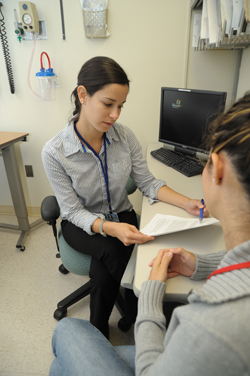 |
|
Hilda Tejero is working as a summer student in the Department of Transfusion Medicine for the second year, looking at the transmission of hepatitis C.
|
The six CC summer students worked in the Department of Transfusion Medicine; the Rehabilitation Medicine Department; the Department of Laboratory Medicine; and the Office of Communications, Patient Recruitment, and Public Liaison. “This additional support from ARRA provided the Clinical Center with an wonderful opportunity to offer the rich research environment in these Clinical Center departments to six excellent students,” said Dr. Frederick Ognibene, director of the Office of Clinical Research Training and Medical Education.
Hilda Tejero, a second-year medical student at The George Washington University, planned to continue the work she began last summer in the Department of Transfusion Medicine without payment, but was then awarded American Recovery and Reinvestment Act funding. “I almost came back to the Clinical Center as a volunteer,” she said. “I love working here; I think some people don’t realize how amazing this institution is.”
She worked with Dr. Harvey Alter, clinical studies chief of the DTM Infectious Diseases and Immunogenetics Section, and Dr. Cathy Cantilena, DTM staff clinician, on their protocol studying the risk of sexual transmission of hepatitis C infection from chronic carriers to their sexual partners. Tejero responded to Institutional Review Board stipulations, recruited patients who participated in previous protocols to contact their long-term sexual partners, and administered questionnaires to sexual partners of prior patients regarding risk factors and sexual practices.
Tejero also worked with Dr. Susan Leitman, chief of the DTM’s Blood Services Section on a protocol to determine whether oral ingestion of high levels of probiotic supplements causes an increase in the amount of antibody to certain blood types.
Tejero split her time between the two projects and is grateful for the opportunity to work with patients. She speaks four languages—English, Spanish, French, and German—and enjoys using her abilities in a medical setting. “I am really interested in clinical research; I need the human aspect of medicine,” she said.
Originally from Miami, Tejero holds a bachelor‘s degree in French from the University of Florida and a Master of Public Health from Florida International University. In the future, she is leaning toward either general pediatrics or radiology and is considering returning to the NIH after medical school for a clinical research residency or a rotation. “The people here are such experts in their fields and such great teachers,” said Tejero.
Kim Golden, another CC summer intern here thanks to the American Recovery and Reinvestment Act, worked with Dr. Frances Sheehan-Gavelli, an investigator in the Rehabilitation Medicine Department’s Physical Disabilities Branch. Golden is originally from Detroit and relocated to Silver Spring, Md., to attend medical school. She is also extremely grateful for the opportunity—“Spending a summer here is a good introduction to what research is about.”
Golden, who has a bachelor’s degree in biomedical science from Grand Valley State University, is entering her second year of medical school at Howard University College of Medicine. She learned about the summer internship program when Walter Jones, who leads diversity management and minority outreach in the OCRTME, gave a presentation about summer research opportunities at the CC to her class.
A typical day at Golden’s internship involved helping to acquire magnetic resonance images and then outlining the muscle boundaries using MIPAV (an image analysis program developed at NIH). From these data she generated a full 3-D muscle model, allowing its volume to be computed. The ultimate goal is to develop a predictive model of quadriceps musculature volume, which would have broad ranging impact on a number of musculoskeletal pathologies, such as cerebral palsy. “This is a really great opportunity. I like the lecture series for students, and I really enjoy my project,” said Golden.
Previously, Golden interned with an NIH-affiliated extramural research program, which intensified her interest in clinical research. “This summer I have gotten reassurance that research is something I still want to pursue in the future,” she said.
Golden has not chosen a specialty but does know that she wants to work in medically underserved areas, perhaps returning to practice in her native Detroit.
Another second-year Howard University College of Medicine student, Jontel Dansby worked with Clara Moore of Nursing and Patient Care Services’ Adult and Behavioral Health Unit on a protocol testing a new drug that targets opioid receptors in the brain as a treatment for patients with anxious major depressive disorder.
She plans on pursuing a career as a surgeon and, as part of her summer program at the CC, got the opportunity be in an operating room during surgery. “I’m glad I was chosen,” Dansby said. “This place is the best—world renowned—there is so much history here.”
Dansby, Golden, and a host of other summer interns presented their research and findings in a scientific poster at the 2009 Summer Poster Day session on the morning of August 6 in the Natcher Conference Center.
Back to Top
Registration opens for next year of the CC’s global course IPPCR
The NIH Clinical Center is the nation’s largest hospital devoted entirely to clinical research—medical research that involves people. What is behind such practice—the epidemiologic methods, the ethical and legal issues, and the regulations on human subjects research?
The CC course Introduction to the Principles and Practice of Clinical Research aims to educate on the infrastructure required to perform clinical research and on the steps involved in developing and funding research studies.
Registration for the 2009-2010 Introduction to the Principles and Practice of Clinical Research course is now open. Of interest to physicians and other health professionals planning a career in clinical research, this year’s session will run from October 19 through March 9.
Classes will be held on the NIH campus on Monday and Tuesday evenings from 5:00 pm to approximately 6:30 pm. There is no charge for the course; however, the textbook Principles and Practice of Clinical Research, Second Edition is suggested as supplemental information for the course. A certificate will be awarded upon successful completion of the course, which is based on a final examination.
A course in biostatistics, such as STAT 200 or STAT 500, offered by the Foundation for Advanced Education in the Sciences may provide supplemental benefit to those enrolled in the Introduction to the Principles and Practice of Clinical Research.
More than 950 students registered for last year’s course, which was also video broadcast to 18 domestic and international locations and Web-based at three locations. In addition, the course was taught live to over 740 students at two locations in China: Beijing and Chengdu. For additional information or to register, visit the course Web site at http://www.cc.nih.gov/training/training/ippcr/application.html or call the CC Office of Clinical Research Training and Medical Education at 301-496-9425. The deadline to register is October 9. An e-mail confirmation will be sent to those accepted into the program.
Back to Top
USPHS celebrates officer promotions
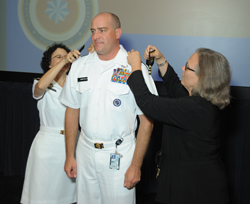 |
Clinical Center nurse Brent Bonfiglio is promoted to commander by Rear Admiral Carol Romano (right) and his nurse manager, Joan Sheeron, at a US Public Health Service ceremony July 23.
|
Family members, coworkers, and fellow US Public Health Service officers celebrated the promotion of 32 NIH employees at the Seventh-Annual USPHS Commissioned Corps Promotion Ceremony July 23 in the Lipsett Amphitheater.
The ceremony opened with the presentation of the colors by the Surgeon General’s Honor Cadre and the singing of the national anthem and the Public Health Service’s March by the USPHS Commissioned Corps music and choral ensemble. “It is my pleasure to welcome all of you to celebrate together the accomplishments of this diverse group of uniformed officers,” said Dr. Lawrence A. Tabak, NIH acting deputy director.
Twelve Clinical Center USPHS Officers in four of 10 categories were promoted at the ceremony—with the changing of shoulder boards to denote the new position.
Within the dietician category, Nancy Sebring was promoted to captain and Jennifer Graf was promoted to lieutenant commander. Under the nurse category, Brent Bonfiglio was promoted to commander and Tracey Chinn, Shayna Herbert, Jennifer McLellan, Reggi Parker, April Poole, and Leslie Wehrlen were promoted to lieutenant commander. Mary Byrne, a pharmacy officer, was promoted to commander. Among the Health Services officers, Sabrina Ivory was promoted to lieutenant commander; and among the therapist officers Kieu-Phuong Vu was promoted to lieutenant commander.
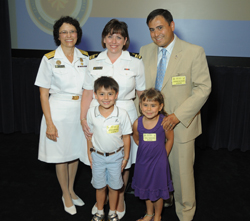 |
Rear Admiral Carol Romano (left) poses with recently promoted nurse specialist LDCR Leslie Wherlen and Wherlen’s husband Andrew and children Nathan and Holly.
|
The USPHS Commissioned Corps is one of America’s seven uniformed services—an elite team of more than 6,000, full-time public health professionals dedicated to advancing public health science.
“The mission of each and everyone here is at the forefront of public health and helping everyone live healthier, better lives,” Acting Surgeon General Rear Admiral Dr. Steven K. Galson said at the ceremony, “and in this institute, the work you are doing shines.”
Back to Top
NIH and Wikipedia work to spread knowledge of medical research
Dr. Ronald Summers, chief of the Clinical Center’s Radiology and Imaging Sciences’ Image Processing Group, is impressed by the thorough coverage of Wikipedia, the free online encyclopedia.
“It’s a mode of conveying information on technical, scientific, and health topics to a very broad audience,” Summers said. “Every time I Google something it’s one of the first sites to come up.”
He had previously looked into editing a Wikipedia page, but found the process intimidating. Summers put the project aside until the NIH Office of Communications & Public Liaison hosted the NIH Wikipedia Academy on July 16. Staff and volunteers from the Wikimedia Foundation, the nonprofit organization that operates Wikipedia, came to campus for a day-long conference to explain the philosophy and mechanics of the site.
“With the broad range of experts from the National Institutes of Health, we see a great opportunity for increasing the quality of all health-related information on Wikipedia,” said Sue Gardner, executive director of the Wikimedia Foundation.
Summers attended and learned that the editing process required only a couple simple formatting codes. He edited a page that night. “I see it as part of my mission as a scientist to communicate,” said Summers.
The Web site—www.wikipedia.org—has instructions on editing pages. For more information on NIH protocol and intent, contact the NIH OCPL.
Back to Top
NIH-wide data repository and user center go live
It is so great that we can expand horizons with new datasets and at the same time protect the privacy of our human subjects,” said Dr. Michael Gottesman, NIH deputy director of intramural research, at the Biomedical Translational Research Information System go-live event on July 30.
The launch of the NIH-wide research data repository allows principal investigators with active protocols to view their patients’ identified data from the Clinical Center’s Clinical Research Information System, the Clinical Research Information Management System of NIAID, and the NIAAA database. In September NIH researchers will be able to access de-identified patient data from the same systems.
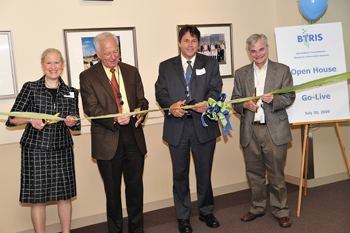 |
Kicking things off on July 30 were (from left) Elaine Ayres, deputy chief of the CC Laboratory for Informatics Development; Dr. Jack Jones, NIH Chief Information Officer; Dr. Jim Cimino, chief of the CC Laboratory for Informatics Development and BTRIS program director; and Gottesman.
|
“I’ve been so fortunate to work with these great folks to get this built,” said Dr. Jim Cimino, speaking to his team. They put together the top five uses of BTRIS: (1) Create an IRB Inclusion Enrollment Report in seconds. (2) Search across one protocol or multiple protocols for demographic data. (3) Tell an investigator all the patients on his/her protocol that receive a particular drug. (4) Find all an investigator’s patients with a lab value over a certain amount. (5) Create subsets of protocol subjects for retrieving detailed data sets.
The day also marked the opening of the BTRIS User-Support Center in the Hatfield Building’s 4-2480 (to the right of the Medical Board Room). At the center, BTRIS staff will provide walk-in support for users from 8:30 am to 5:00 pm, Monday through Friday, through October 30.
Back to Top
Fellow returns for another go-round at her research
Dr. Sarah Kranick has returned to the Clinical Center to continue work she started six years ago as a fellow in the Clinical Research Training Program.
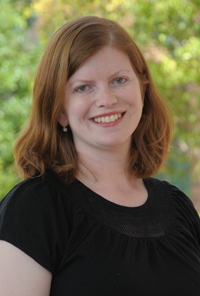 |
|
Dr. Sarah Kranick returned to the Clinical Center after finishing medical school and her residency. She originally worked in NINDS as a 2003-2004 CRTP fellow.
|
While enrolled in the Medical College of Georgia, Kranick spent a year—from 2003 to 2004—with Dr. Mark Hallett, chief of the National Institute of Neurological Disorders and Stroke’s Medical Neurology Branch, Human Motor Control Section. After graduating and completing her neurology residency at the Hospital of the University of Pennsylvania, Kranick returned to Hallett’s laboratory for a movement disorders fellowship—doing work similar to the protocol she helped write as a Clinical Research Training Program fellow studying movement in schizophrenics with passivity phenomenon.
These studies use electroencephalography to look for potential electrical changes in the brain leading up to and during abnormal movements. “The goal is to understand what causes the brain to translate stress into movement, in the case of psychogenic movement disorders, and to identify targets for treatment,” said Kranick.
She has great interest in psychogenic movement disorders and spoke on how often such conditions are misdiagnosed or dismissed due to the busy pace of clinical practice. The research environment of NIH allows patients to develop a more trusting relationship with their physicians, which allows them to open up more, Kranick said.
The caring and imaginative staff pulled her back to NIH, too. “The people here are just happy. They seem empowered to try new things and to ask questions,” she said.
While her interest in the research field and affection for NIH have not faltered since medical school, other things are different, Kranick said. “It’s funny to be back now because my life here has changed—now I’m in the suburbs, married with a 15-month-old daughter.”
Back to Top
Pharmacy deputy chief receives Award of Excellence
At the Hematology/Oncology Pharmacy Association (HOPA) Fifth Annual Conference in Miami in June, Dr. Barry Goldspiel, deputy chief of the Clinical Center Pharmacy Department, received the 2009 HOPA Award of Excellence. The association’s highest honor, the award recognizes a HOPA member who has made a significant, sustained contribution to or provided excellent leadership in improving or supporting hematology/oncology pharmacy. Goldspiel was cited as “a recognized leader in oncology pharmacy who has created the opportunities for the profession to grow to meet the evolving needs of patient care.”
At right, HOPA 2008-2009 President Cindy O’Bryant presented Goldspiel with the 2009 Award of Excellence plaque.
Back to Top
Dietetic trainees swallow a spoonful of success
The NIH Dietetic Internship Program through the Clinical Center Nutrition Department graduated three at a ceremony on July 10. LCDR Merel Kozlosky, program director, acknowledged (sitting from left) Sara Hauck, Kelly Verdin, and Kimberly Wong for completing the “rigorous and renowned program” and thanked the “significant groups in their journey:” preceptors, family, and nutrition staff. In attendance were dietitians (from left): CAPT Nancy Sebring; Marnie Dobbin; Kozlosky; LCDR Jennifer Graf; CAPT Madeline Michael, chief of Clinical Nutrition Services; Kristy Suhr; Beth Moylan; Kirsten Zambell; LT Rachael Drabot; and Jennifer Widger, chief of the Food Service Section.
Back to Top
Survivors recount experiences during Teen Retreat
As part of the Teen Retreat, an event held twice a summer and coordinated by The Children’s Inn and the Clinical Center’s Rehabilitation Medicine Department’s Recreation Therapy Section, three young cancer survivors and the sibling of a former HIV patient shared their stories on July 28.
From left, Mario Martinez, 18, overcame a brain tumor diagnosed when he was 13 to enter Elon University last year as a pre-medical student. He spoke on entering high school with no hair and the difficulty of transitioning back to a life without cancer when in remission.
Kimmie Jappell, 22, visited NIH with her older sister Bernie who died from HIV at age 13. She now works for the Northern Virginia AIDS Ministry and honors her sister’s memory by looking for the fun in life.
Kevin Chen, 26, will start at Georgetown University School of Medicine this month hoping to go into pediatric oncology. Osteosarcoma stole his leg below the knee when he was 18, but Chen told the Inn residents he still plays tennis, runs, and “can school all of you on the basketball court.” His prosthetic was the source of many questions from the group, including if it is difficult to get through airport security—he’s automatically given a private screening.
Roger Berdine, 21, beat Ewings Sarcoma diagnosed at age 10 with a hard-to-handle mix of radiation, chemotherapy, and multiple surgeries. “I am a better person because of what I went through, and I have learned what is really important in life,” Berdine said.
After they shared their own stories, the panelists encouraged the patients and their siblings present to ask questions and share their own stories.
Back to Top
Investigators greet research fellows at reception
The Clinical Center welcomed a new crop of clinical fellows at a reception July 8 after a day of orientation. Dr. Constantine Stratakis (left)—acting scientific director, head of the Program on Developmental Endocrinology and Genetics, and director of the Training Program on Pediatric Endocrinology at the National Institute of Child Health and Human Development—and Dr. Richard G. Wyatt, deputy director of the NIH Office of Intramural Research, mingled with new fellows Dr. Fariha Kamran (right) and Dr. Alison Boyce. Both are starting a clinical fellowship in pediatric endocrinology with NICHD. Kamran graduated from King Edward Medical College in Pakistan and did her residency at Nassau University Medical Center. Boyce graduated and completed her residency at Eastern Virginia Medical School.
Back to Top
Wind ensemble soothes with a serenade
Members of the Baltimore Symphony Orchestra serenaded Clinical Center staff, patients, and visitors with Antonin Dvorak’s Serenade for Winds, Opus 44, July 13 in the Hatfield Building’s atrium.
Maureen Gormley, CC chief operating officer, introduced the four movement performance, emphasizing the CC’s commitment to building a positive environment for healing, from the design of the atrium to the presence of the Steinway grand piano.
Joseph Young, Baltimore Symphony Orchestra/Peabody conducting fellow, directed the wind ensemble and pointed out that though the ensemble’s summer residence is “just one red line stop away” at The Music Center at Strathmore, it was the first time the group had been to the NIH. “The piece that we are playing today originated from a place just like this one, from an open forum,” said Young, gesturing towards the open, light-filled atrium.
Dozens of listeners gathered as the acoustics of the performance echoed through the building and looking up, people could be seen on all seven floors of the atrium, peering through the glass at the musicians seated below.
The ensemble included 12 musicians: two oboes, two clarinets, two bassoons, three french horns, one contra bassoon, one cello, and one double bass.
“It is our pleasure to be here and to bring a little music into your lives and send you off with a lighter step in your day,” said first chair oboe, Jane Marvine.
“We, as an orchestra, feel that it is very important to bring music into other peoples lives and the community around us,” Marvine said. “Music matters for the healing of spirit which helps the healing of the body and of the mind. We are proud to share with you a few notes to help heal.”
The concert closed with a reprise of the symphony’s first movement and a standing ovation.
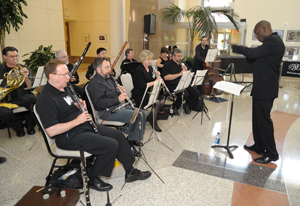 |
Joseph Young (right) conducted a Baltimore Symphony Orchestra wind ensemble in the Clinical Center atrium on July 13.
|
Back to Top
Confused about what to recycle?
The Clinical Center Green Team wants to remind staff of the CC Recycling Guidelines. Please note, medical records or paperwork containing sensitive information must be shredded and not recycled.
Visit http://www.nems.nih.gov/aspects/waste/programs/recycling.cfm for more information. If a large hallway NIH recycling container needs to be emptied, contact the NIH Recycling Center at 301-402-6349.
|
Mixed Paper
|
Commingled
|
|
-
Aluminum Cans and Tin Foil
-
Steel and Tin Cans
-
All Plastic Bottles, Cups, and Containers (Plastic resin codes #1, 2, 3, 4, 5, 6 [Non-Styrofoam], and 7)
-
Yogurt Containers (Rinsed)
-
Prescription Bottles
-
Glass Bottles and Jars (No Pyrex)
-
Food Storage Containers
-
Grocery, Retail, Sandwich, and Other Miscellaneous Plastic Bags
-
Plastic Utensils (Clean)
-
Buffer and Saline Bottles
|
Back to Top
Scan shows successful Sibling Day
The Second Annual Sibling Day, a collaboration between the National Cancer Institute, the Clinical Center and The Children’s Inn, on July 14 led 11 siblings of NIH patients to different CC departments and through therapeutic exercises to better understand and express what they are going through. The children visited the CC’s Department of Laboratory Medicine and got to take a ride in a mock scanner in the National Institute of Mental Health Behavioral Health Clinic. Below left, clinic manager Frances Myers demonstrated to Ane Roesvik, right, and Anna Torres, left, how the simulator works; Samantha Druckenmiller played patient. The mock scanner is used to introduce the MRI procedure to children to test if they could manage the high-cost/high-demand imaging test, Myers said. With the CC’s Rehabilitation Medicine Department’s Recreation Therapy Section, the children shared tips on coping with a sibling’s illness and made worry boxes with art therapist Megan Robb. Sibling Day ended with an awards ceremony at The Children’s Inn. The event’s director, Dr. Lori Wiener, coordinator of NCI’s Pediatric Psychosocial Support Program, presented each participant with a super sibling certificate. “They have shown us strength, courage, insight, and compassion. They are truly our teachers,” Wiener told the families and staff gathered at the ceremony. Shannon Dier, a summer student working with Wiener, also played a significant role in organizing the day’s events.
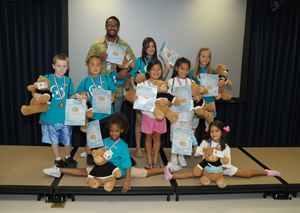 |
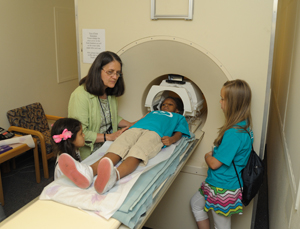 |
Back to Top
News Briefs
No touch required for sanitizer dose
The NIH Office of Research Facilities has installed more than 70 wall-mounted or free-standing, automated hand-sanitizer dispensers around the Clinical Center as part of a campus-wide initiative in response to an influx in communicable disease, namely H1N1 flu. The machines filled with alcohol-based sanitizer are at elevator lobbies, CC entrances, cafeterias, and other public areas. Do not move the free-standing dispensers, as ORF must know where they are to refill the product and replace the batteries. To report a problem with a machine or request a refill, contact the ORF help line at 301-435-8000.
Piano Concert Series upcoming performance
Jeffrey and Olivia Ly will perform a program of duet pieces by Strauss, Bach, Gershwin, Dvorák, Schubert, Brahms, and others on August 20 from noon to 1 pm.
 |
Olivia Ly, 13, and Jeffrey Ly, 14, began studying piano with Dr. Bella E. Oster at the European Academy of Music and Art in Burtonsville, Md., at the ages of 3 and 5. These young pianists have performed on many prestigious stages in the United States and abroad—at the United Nations, the White House, the US Capitol, the Joan and Sanford I. Weill Recital Hall at Carnegie Hall, The John F. Kennedy Center for the Performing Arts, the Lincoln Center for the Performing Arts, and Harvard University. Both Jeffrey and Olivia have received many accolades including gold medals from The International Association for Musically Gifted Children, Inc. They also won first place in 2001 and 2003 at the Bartok-Kabalevsky-Prokofiev International Piano Competition. The Lys have been profiled internationally and nationally on television programs and in magazines and newspapers and have recorded many educational CDs.
Olivia and Jeffrey are both home schooled and enjoy reading, writing, and traveling in addition to piano performance.
CRTP welcomes 13th class of fellows
The NIH Clinical Research Training Program welcomed 30 medical students representing 18 different schools for its 2009-2010 academic class in July. The 12-month educational experience, now in its 13th year, provides creative, research-oriented medical students hand-on experience in clinical and translational research. The students, who are taking time away from medical school for a year of academic enrichment, work with NIH clinical and translational research investigators who serve as mentors. In addition to conducting and collaborating in active research projects, the fellows attend clinical rounds, courses and seminars, and present their research findings to the NIH community and at various conferences.
Since the program began in 1997, 280 students representing 79 schools have participated. This year’s participants were selected from an extremely competitive pool of 118 applicants, which is a record. Since 1998 the training program has been supported jointly by the NIH and the Foundation for NIH through grants from Pfizer Inc as part of the company’s commitment to public-private partnerships. In 2004, the program was expanded to accept 30 students a year thanks to support through the NIH Roadmap as part of its Re-engineering the Clinical Research Enterprise initiative.
NIH employee shows book art in CC exhibit
Judith Folkenberg, a writer for the National Library of Medicine, is showing off another kind of her art in an exhibition outside Clinical Center Admissions. Folkenberg is a book artist—“not only someone who makes books in the conventional sense, photo albums, journals or notebooks with say, decorative or unique covers, but also uses or adapts binding techniques from other countries, and from past centuries,” she described in her artist’s statement.
“A book artist may come up with new forms of binding or cohesion and may also use materials not normally associated with books, such as bark, plywood, found objects, and metal.”
Folkenberg has worked with the NLM for 10 years and has shown her art work at the Strathmore in Bethesda, the Arts Guild of Sonoma in Calif., and Pyramid Atlantic’s Book Arts Fair at the Corcoran Gallery of Art in DC.
The CC exhibit will run through August 28 and includes the work at right with book covers made from wine crates and pages made from old calendars, paper bags, pages torn from existing books, and blank papers.
Back to Top
Participants sought for clinical trials
Immune response
Researchers in study 09-DK-0055 will give healthy volunteers 18 years or older short-term treatment of sitagliptin to determine if and how sitagliptin alters immune function. All study-related tests are provided at no cost. Compensation is provided. To apply to participate, call 1-866-444-2214 (TTY: 1-866-411-1010).
Sleep deprivation and obesity
Researchers in study 06-DK-0036 are looking for obese adults ages 18 to 50 who sleep less than six hours a night to examine the relation of sleep to body weight, to the amount of body fat and to the level of hormones that control appetite. Medical history and a physical examination are provided at no cost. Compensation is provided. For more information, call 1-866-444-2214 (TTY: 1-866-411-1010).
Pain in the neck
If you are a healthy individual older than 21 years experiencing neck pain for three months or less, you may be eligible to participate in a neck pain study and receive a comprehensive cervical musculoskeltal examination. This is not a treatment study. For more information, e-mail neckpainstudy@gmail.com or call 301-451-7514.
Back to Top
Clinical Center Grand Rounds
12pm, Lipsett Amphitheater
All lectures will be videocast at http://videocast.nih.gov.
August 5, 2009
Is the Pharmaceutical Industry Ready for Personalized Medicine?
Frank L. Douglas, PhD, MD
Senior Fellow
Ewing Marion Kauffman Foundation
August 12, 2009
How Should We Make Treatment Decisions for Incapacitated Patients?
David S. Wendler, PhD
Head, Unit on Vulnerable Populations
Department of Bioethics
NIH Clinical Center
August 19, 2009
The Challenges of Collaboration and Team Science: Everything You Didn’t Learn in Kindergarten
Howard Gadlin, PhD
NIH Ombudsman and Director, Office of the Ombudsman
Center for Cooperative Resolution
Office of the Director, NIH
L. Michelle Bennett, PhD
Deputy Director, Center for Cancer Research
National Cancer Institute
August 26, 2009
Knowledge Translation Research ‘Type 2’: Where the Smart Researchers Are Going
R. Brian Haynes MD, PhD
Professor of Clinical Epidemiology and Biostatistics
Chief, Health Information Research Unit
Faculty of Health Sciences
McMaster University
Back to Top
This page last updated on 12/14/2017


 The information on this page is archived and provided for reference purposes only.
The information on this page is archived and provided for reference purposes only.